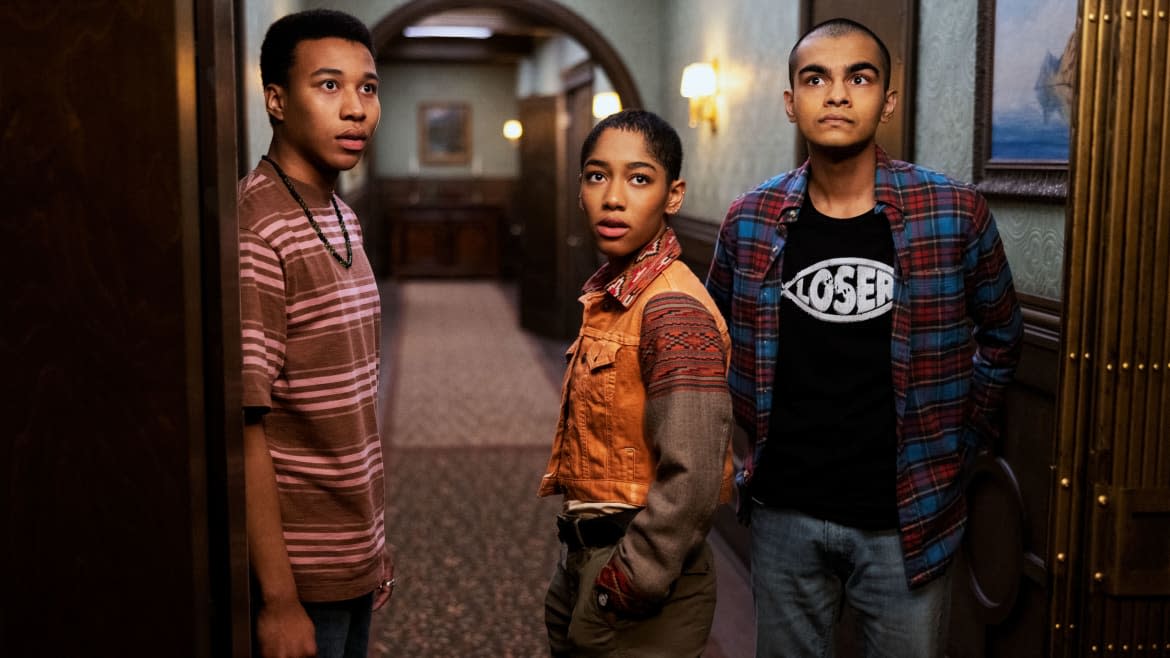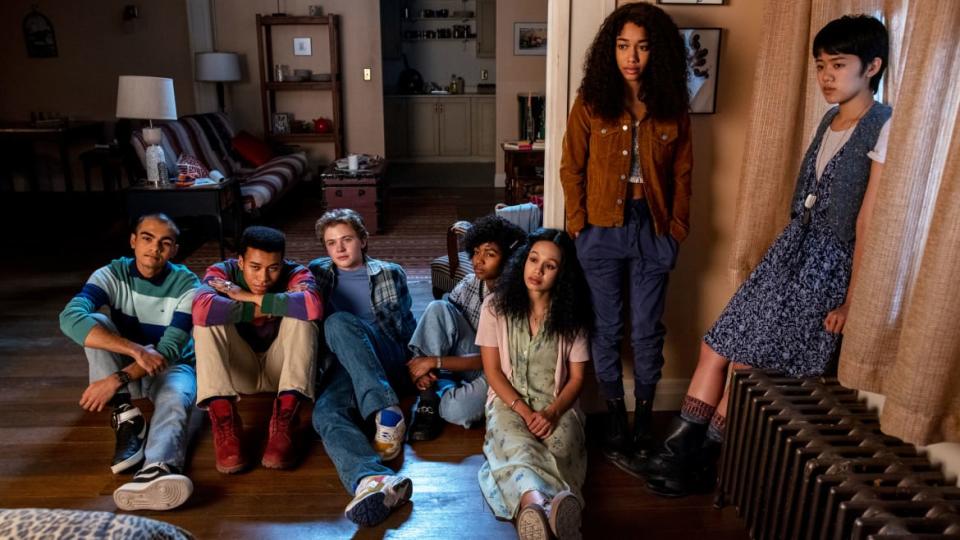‘The Midnight Club’: Netflix’s Teen Horror Series Is Frighteningly Light on Thrills

- Oops!Something went wrong.Please try again later.
- Oops!Something went wrong.Please try again later.
- Oops!Something went wrong.Please try again later.
Fractured haunted-house ensemble stories about mortality, family, trauma, and shadowy apparitions hiding in the dark have become writer/director Mike Flanagan’s Netflix niche, as evidenced by The Haunting of Hill House and The Haunting of Bly Manor. He returns to that arena, albeit with a teen twist, with The Midnight Club, a 10-episode adaptation of author Christopher Pike’s YA novel that, formally and thematically, slots in comfortably with his prior work. Yet in this case, such familiarity breeds, if not contempt, then certainly frustration. Flanagan leans so heavily on gooey and preachy melodrama—while going unreasonably light on scares or resolutions to his central mysteries—that his latest streaming series (Oct. 7) proves a collection of tired platitudes dressed up in faux-horror garb.
The Midnight Club begins with tragedy: the 1994 terminal thyroid cancer diagnosis of Ilonka (Iman Benson), which catastrophically derails her plans for college and beyond. With every treatment option exhausted, Ilonka convinces her foster dad Tim (Matt Biedel) to let her move to Brightcliffe Hospice, a place that lets teenagers transition on their own terms. Despite the fact that even looking up Brightcliffe on the internet gives her spooky hallucinations of hooded figures, Ilonka decides this is the spot for her. When she shows up, the woman running the facility, Dr. Stanton (A Nightmare on Elm Street star Heather Langenkamp), explains that their guiding philosophy is not to treat fatal disease as a “battle” that must be fought, but to focus on the present, since “every living day here is a win.”
‘Werewolf by Night’ Is the Rare Marvel Series That Should Have Been Longer
That’s easier said than done, considering that everyone at Brightcliffe is facing a death sentence. Ilonka’s housemates are a motley crew: angry and hostile wheelchair-bound roommate Anya (Ruth Codd); cellist and compulsive liar Cheri (Adia); nerdy video gamer Amesh (Sauriyan Sapkota); reticent and depressed Natsuki (Aya Furukawa); outgoing but bitter Spence (Chris Sumpter); devoutly religious Sandra (Annarah Cymone); and friendly, cute Kevin (Igby Rigney). Ilonka doesn’t immediately fit in with this close-knit gang. That is, until she surreptitiously follows them to the library, where each night at the stroke of midnight, they gather to convene The Midnight Club, whose origins date back to Brightcliffe’s inception, and which revolves around members telling macabre tales. Their pact is that, when they die, they’ll send a message back from the great beyond to confirm that there’s an afterlife.
The Midnight Club thus divides its time between the worlds of the real and the imaginary, which are inherently intertwined, given that the kids’ fanciful narratives—whether operating in the science-fiction, horror, serial killer, or detective genres—are rooted in their own backstories and/or personal issues (and thus star the kids as their made-up proxies). Unfortunately, the yarns they spin are both too obvious as thinly veiled fictionalizations of their own plights (and expressions of the show’s themes), and also too rushed to work as standalone nightmares. Even the best of them, like Natsuki’s saga about an endless nighttime drive, start strong and then peter out into predictable and leaden lectures. Similarly, a twist at the start of episode seven, borrowed from the Lost playbook, is dropped before it can be exploited for head-spinning thrills. Though they’re meant to be the proceedings’ unique twist, The Midnight Club’s campfire-style stories are underwhelming at best, and runtime-padders at worst.
Flanagan, who co-wrote every installment and directed the first two, remains adept at crafting a mood of archaic-mansion malevolence and dread. He embellishes his action with plentiful ’90s soundtrack cuts from the likes of Salt-N-Pepa, Soundgarden, and Collective Soul, and delivers a few smart self-referential jabs at jolt scares and the notion that ghosts only seem to make contact in nonsensically bleak fashion. Yet there’s nothing creative about the smoky specters and elderly ghouls populating Brightcliffe, nor anything particularly surprising about Ilonka’s investigation into the facility’s past.
Ilonka is determined to learn how a former resident named Julia Jayne (Larsen Thompson) walked out of Brightcliffe healed. She soon deduces that it has to do with the Paragon, a cult that lived in the house years before Dr. Stanton turned it into a hospice, and that was obsessed with communing with ancient Greek goddesses known as the Five Sisters, who had magical healing abilities. This requires Ilonka to partake in some sleuthing and sneaking around Brightcliffe, locating old diaries and stumbling upon hidden rooms. Alas, this whole mystery turns out to be rather straightforward, and if you think it might also involve Shasta (Midnight Mass’ Samantha Sloyan)—a woman who roams the adjoining forest gathering its herbal goodies for her naturopathic collective and their line of health products—well, that’s because The Midnight Club operates according to transparently hackneyed rules.

The Midnight Club’s young cast is generally charismatic, but Flanagan and company’s scripts often fall into schmaltzy ruts, going on and on about the fear of death, the need to embrace life, and the preciousness of every moment until it all loses any real meaning. While numerous Flanagan vets lend a hand, the show’s frights are underwhelming, rehashing images and tricks that the director has put to better use in everything from Ouija: Origin of Evil to Doctor Sleep. The fact that The Midnight Club is intended for younger viewers doesn’t excuse the tossed-off nature of these wannabe-chilling moments, whose dreariness exacerbates the series’ overarching lack of urgency—a problem that, like so many Netflix affairs, might have been remedied by a shorter episode count.
In the end, The Midnight Club arrives at the very place one expected it to from the start, except that once it reaches that destination, it punts on offering up answers to the key questions it’s repeatedly raised—leaving those, presumably, for a second season. Receiving so little clarity on the show’s primary mysteries after 10 hours feels like a cheat, and far more aggravating than the squishy teen romance and heartbreak in which it earnestly indulges. To reference a rubber band-related metaphor that factors into one character’s tale, The Midnight Club is ultimately proof that audiences can only be strung along for so long—without anything in the way of satisfying payoffs—before they snap.
Get the Daily Beast's biggest scoops and scandals delivered right to your inbox. Sign up now.
Stay informed and gain unlimited access to the Daily Beast's unmatched reporting. Subscribe now.

